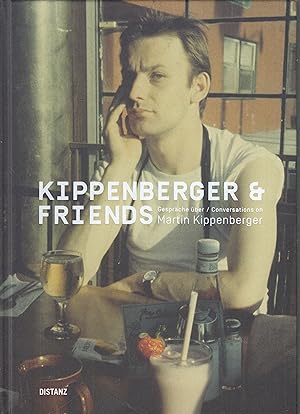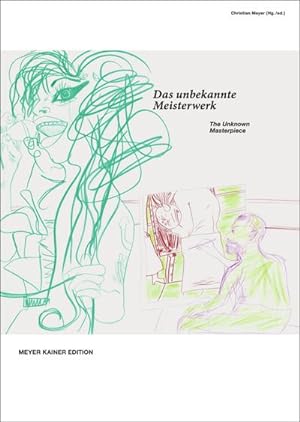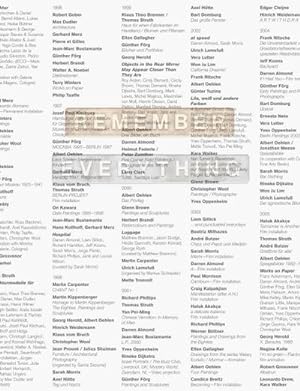kippenberger friends (8 Ergebnisse)
Produktart
- Alle Produktarten
- Bücher (8)
- Magazine & Zeitschriften
- Comics
- Noten
- Kunst, Grafik & Poster
- Fotografien
- Karten
-
Manuskripte &
Papierantiquitäten
Zustand
Einband
Weitere Eigenschaften
Land des Verkäufers
Verkäuferbewertung
-
Kippenberger. Der Künstler und seine Familien [SIGNED BY AUTHOR]
Verlag: Berlin Verlag, Berlin, 2007
ISBN 10: 3827007046ISBN 13: 9783827007049
Anbieter: ERIC CHAIM KLINE, BOOKSELLER (ABAA ILAB), Santa Monica, CA, USA
Buch Erstausgabe Signiert
Hardcover. Zustand: near fine. First edition. Signed Susanne Kippenberger, Los Angeles, 23. 8. 2011. Octavo. 575 (1)pp. Original photo-illustrated dustjacket over red cloth with white and gray lettering on spine. Photo-illustrated endpapers. Frontispiece photograph. Silver ribbon marker. The Enfant Terrible of German art in the late 20th century here in a portrait by his sister Susanne Kippenberger, an artist obsessed with controlling his actions and their impact who is known for his prolific output in a wide range of styles and media. Susanne talks about her unresting brother growing up in the industrial region of West-Germany, the "Ruhrgebiet," their family, the artist friends visiting the "Open House," his addictions to drugs, alcohol, acknowledgment, and love. The title of one of his larger pieces, "Transportable Subway Entrance," is indicative for this cynical/critical as much as restless artist, considered to be one of the great conceptual artists of the 20th century. Martin Kippenberger died in 1997 of liver cancer at the age of 44. Rare signed copy of this intimate as well as substantial biography. Text in German. DJ, binding and interior in near fine condition.
-
Kippenberger fanden wir schon immer gut. Familie Grässlin. / We have allways found that Kippenberger is great Family Grässlin.
Verlag: St. Georgen/Schwarzwald, Collection Grässlin. 1994., 1994
Anbieter: Antiquariat CoBrA, Oberrohrbach, Österreich
St. Georgen/Schwarzwald, Collection Grässlin. 1994. 26,9 x 24,5 cm. 424 pp. With 392 green on white illustrations. 424 Seiten mit 392 Tafeln mit Abbildungen in grün/weiß. Layout und Konzeption Kippenberger (minimale Gebrauchsspuren, sehr gutes Exemplar) Softcover. The Grässlin family from St. Georgen in the Black Forest, close friends of Kippenberger for many years, owns the largest collection of his works. This book (the title translates as "We always thought that Kippenberger is great") is a catalogue of the family's collection, designed by the artist in collaboration with Sabine Grässlin. In reference to St. Georgen, Kippenberger had the entire catalogue printed in "Black Forest Pine Green", according to the maxim "Green Forest instead of Black Forest". A near fine copy. Scarce. Layout und Konzeption Kippenberger (minimale Gebrauchsspuren, nahezu verlagsfrisch). Sprache: Deutsch. *** Bitte kontaktieren Sie mich immer BEVOR Sie bestellen! Für ausführliche Beschreibungen und Bilder sowie günstigere Versandoptionen kontaktieren Sie mich bitte per Email! Please contact me always BEFORE you order! For detailled descriptions and photos as well as cheaper shipping options please send an email! ***.
-
Nach Kippenberger *
Erscheinungsdatum: 2003
Anbieter: Antiquariat / Buchhandlung Walther König, Köln, NRW, Deutschland
Verbandsmitglied: BOEV
0. Nach Kippenberger. Wien/Eindhoven 2003/04. Hrsg. von Eva Meyer-Hermann & Susanne Neuburger. Vorw. von Jan Debbaut & Edelbert Köb. Beitr. von Diedrich Diederichsen, Lucy McKenzie, Martin Prinzjhorn, Kathleen Bühler, Manfred Hermes & Anke Kempkes. 18 x 24 cm. 256 S. mit 338 (266 farb.) Abb., Bibliographie, Chronologie. Broschur. In dt. & engl. Sprache. - Sehr guter Zustand. Das Buch bietet diverse längere Texte, die ein neues Verständnis des Werks Kippenbergers für das Publikum einer Generation "Nach Kippenberger" vorbereiten. Eine Fülle von erläuternden Werktexten gibt darber hinaus Interpretationshilfen zu den in der gleichnamigen Ausstellung gezeigten Werkgruppen. Am Motiv der Architektur belegen die Autoren Kippenbergers Suche nach Sinn und Ort für eine eigene künstlerische Existenz. Das sehr reiche Bildmaterial stammt aus dem Nachlaßarchiv. Darunter finden sich viele bisher unveröffentlichte Abbildungen aus dem Leben und der Arbeit des Künstlers. Die Gestaltung des Buches hat der Künstler und Freund Kippenbergers Hans Weigand übernommen. Sicher der erste erfolgreiche Versuch, das vielschichtige Werk retrospektiv aufzuarbeiten. ***** The catalogue book contains various longer essays, which pave the way for a new understanding of Kippenberger`s works for an audience from the generation after Kippenberger. The importance of this book is accentuated by the picture material from the artist`s estate with many previously unpublished photographs from Kippenberger`s life and work.It has been designed by Hans Weigand, a fellow artist and friend.
-
Kippenberger & Friends. Gespräche Über/ Conversations On Martin Kippenberger
Verlag: Distanz Verlag ;, 2013
Anbieter: Stefan Schuelke Fine Books, Köln, NRW, Deutschland
Softcover. Zustand: Sehr gut. Verleger: Distanz Verlag . Herausgeber: Von Perfall, Josephine . Datum: 2013. 224 Seiten mit Farb- und Schwarzweissabb. Deutsch ; Englisch . 4to. (Quartformat). Opappbd./ Hardcover. 'Als Interview- und Fotobuch naehert sich Kippenberger & Friends dem Mythos Kippenberger in 25 Gespraechen mit Kuenstlern, Kuratoren, Galeristen und Freunden. Er enthaelt ca. 55 dokumentarische Fotografien aus den persoenlichen Bestaenden der Freunde, die erstmals veroeffentlicht werden. Nachdenklich, humorvoll, kritisch und auch selbstironisch oeffnet sich so der Blick auf einen, der keinen gleichgueltig gelassen hat. In den sehr persoenlichen Erinnerungen wird nicht nur Kippenberger lebendig. Es entsteht ein dichtes Bild der kulturellen Situation in einem Deutschland, das zwischen Springer-Presse und Studentenrevolte, hedonistischer Konsumkultur und provozierender Rebellion hin- und hergerissen wurde.(Distanz.de). Interviews mit: Roland Augustine, Galerist, New York; Lukas Baumewerd, Architekt; Klaus vom Bruch, Kuenstler; Werner Buettner, Kuenstler; Gisela Capitain, Galeristin, Koeln/Berlin; Zdenek Felix, Kurator; Max Hetzler, Galerist, Berlin; Carmen Knoebel/Brigitta Rohrbach, ehemalige Wirtinnen des Ratinger Hof, Duesseldorf; Kasper Koenig, ehemaliger Museumsdirektor Museum Ludwig, Koeln; Jutta Koether, Kuenstlerin; Christian Ludwig Attersee, Kuenstler; Helmut Middendorf, Albert Oehlen, Kuenstler; Peter Pakesch, Museumsdirektor Joanneum und Kunsthaus, Graz; Friedrich Petzel, Galerist, New York/Berlin; Martin Prinzhorn, Sprachwissenschaftler; Achim Schaechtele, ehemaliger Mitinhaber des S.O.36, Berlin; Stephan Schmidt-Wulffen, Rektor der New Design University, St. Poelten; Elfie Semotan, Fotografin und Ehefrau; Claudia Skoda, Modedesignerin; Helene Winer, Galeristin, New York; Johannes Wohnseifer, Michel Wuerthle, Besitzer der Paris Bar, Berlin; Bernd Zimmer, Heimo Zobernig, . sehr gutes Exemplar.
-
Das unbekannte Meisterwerk
Verlag: Schlebrügge.Editor Aug 2017, 2017
ISBN 10: 3903172073ISBN 13: 9783903172074
Anbieter: AHA-BUCH GmbH, Einbeck, Deutschland
Buch
Taschenbuch. Zustand: Neu. Neuware - At the end of the 1980s, a group of artist friends began questioning the localization of art. Was art based in the personality of the artist, or in the bohemian society around them, in the theoretical concept or even in the artistic object itself To Günther Förg, Martin Kippenberger, Albert Oehlen, and Heimo Zobernig it became clear that in the future, concept and context would acquire a previously unknown significance ('In the future we will no longer make, only think,' as Kippenberger put it). A decisive aspect of their discourse was the 1831 novella The Unknown Masterpiece by Honoré de Balzac.
-
Die Wand. Dramatische Phantasmorgie in einem Aufzug.
Verlag: Berlin, Otto von Holten, privately printed for Gotthard Laske, May 1922., 1922
Anbieter: Hünersdorff Rare Books ABA ILAB, London, Vereinigtes Königreich
Hardcover. Zustand: Very Good. 4to. 67 + [1] pages of text + colophon leaf with author s autograph signature in ink. First word of the title and the name of the recipient on colophon leaf printed in blue letters. Original publisher s half morocco binding with author s name and title in gilt lettering on spine; lightly worn. This dramatization of an interlude in Goethe's Italian journey is the first book privately printed for the noted Berlin bibliophile Gotthard Laske (1882-1936), a wealthy outfitter, who acted as a generous patron to authors, and commissioned a number of publications. Unique edition, beautifully printed in the New Elzevir type on hand-made paper, limited to 100 copies only: the present copy, number 10, was printed for Lilli Wolff, a member of a Berlin music publishing family. The subject of the play, written in 1919 by the wellknown German writer Albrecht Schaeffer (1855-1950), is Goethe s visit to his friend Heinrich Meyer at Stäfa on the Lake of Zürich in 1797 as part of his celebrated Italian journey. The action is set at the Alte Krone Inn, the main characters being Goethe, Meyer, and a young lady also lodging at the inn. Meyer, Privatdrucke von und für Gotthard Laske no 1; Katalog der Sammlung Kippenberg I,143; Wilpert & Gühring, Erstausgaben deutscher Dichtung 1600-1960, 36; for Laske, see Homeyer, Deutsche Juden als Bibliophilen und Antiquare, p.50.
-
[Qabus nama, German]. Buch des Kabus oder Lehren des persischen Königs Kjekjawus für seinen Sohn Ghilan Schach.
Verlag: Berlin, in Commission der Nicolaischen Buchhandlung, 1811., 1811
Anbieter: Antiquariat INLIBRIS Gilhofer Nfg. GmbH, Vienna, A, Österreich
Erstausgabe
8vo. 1 blank leaf, (6), 867, (1) pp. With a double-page-sized genealogical table. Later marbled boards with printed spine label. Edges lightly sprinkled. First German edition of this important Persian Mirror for Princes, published at the expense of the translator. Composed in the late 11th century by Kaika'us, ruler of the Iranian Ziyarid dynasty, the book is regarded as a major work of Persian literature. It describes the creation of the world and God's religious duties; duties towards one's parents; the cultivation of the mind and the power of speech; youth and old age; moderation in food; consumption of wine; chess and backgammon; love; the pleasures of life; hot baths; sleep and rest; hunting; polo; war; accumulation of wealth; trust in words; the purchase of slaves; the purchase of properties; the purchase of horses; marriage; children's education; the choice of friends; how to deal with enemies; forgiveness; punishment and favors; studies and legal functions; commercial law; medicine; astrology and mathematics; poetry; the art of minstrelsy; the service of kings; the qualities of a courtier, secretaries, viziers, generals and king; farming and agriculture; finally, generosity. A Turkish translation was commissioned in the mid-15th century by the Ottoman Sultan Murad II, and it is this version that was in turn translated into German by Diez. - The oriental scholar H. F. Diez (1751-1817) had trained as a jurist but, bored by his administrative occupation, soon left the Prussian civil service and in 1784 went to Constantinople as Frederick the Great's chargé d'affaires at the Sublime Porte. He was ennobled after only two years of successful diplomatic service. Recalled in 1790 on the eve of the Russo-Turkish War, the self-confessed Turkophile soon retired to the life of an independent scholar and book collector in Berlin. His orientalist publications captured the attention of the learned world, and he moved in the circles of Goethe, Gleim, and Alexander von Humboldt, though largely outside the contemporary tradition of academic oriental studies. "Between his years in Constantinople and his death, Diez pursued his Orientalist studies with extraordinary energy. A string of books authored by Diez and mostly self-published appeared in 1811 [.] Even if many aspects of his scholarly life are almost forgotten, his merits, especially for the development of Turkish studies, are noteworthy [.] His works, almost completely printed at his own expense, reflect his interest in the origins of Asian cultures, literatures, and politics, as well as everyday issues and ethics" (J. Gonnella et al. [ed.], The Diez Albums [Leiden, 2017], p. 58, 76). - Occasional insignificant brownstaining, but a good copy in later marbled boards. - Goedeke VII, 586, 36 & 806, 240, 3. Kippenberg I, 1655. Ruppert 1772. Marbach cat., Weltliteratur, pp. 407f. Keudell 954. Not in Wilson (later French translation only).
-
Remember Everything : 40 Years Galerie Max Hetzler
Verlag: Holzwarth Publications Gmbh, 2014
ISBN 10: 3935567693ISBN 13: 9783935567695
Anbieter: AHA-BUCH GmbH, Einbeck, Deutschland
Buch
Buch. Zustand: Neu. Neuware - Aus Anlass des 40-jährigen Bestehens der Galerie Max Hetzler vereint die Gruppenausstellung 'Remember Everything' aktuelle Arbeiten von 21 Künstlern, die durch die Galerie derzeit vertreten werden. Die Dokumentation dieser Ausstellung ist aber nur der Grundstein für dieses Buch, erweitert durch Interviews mit den Künstlern, die an ihre Zeit mit der Galerie und ihre dort ausgestellten Arbeiten zurückdenken. Der einleitende Essay und eine ausführlich bebilderte Chronologie erzählen die ganze Geschichte der Galerie Max Hetzler von den Anfängen in Stuttgart über Köln nach Berlin, die durch das beeindruckende Aufgebot der vielen international bedeutenden Galeriekünstler zu einem Teil der Geschichte der zeitgenössischen Kunst geworden ist.UNDERGROUND GEOGRAPHY(Auszug aus der Einleitung von Jean-Marie Gallais)The group exhibition entitled 'Remember Everything' (after a work by Darren Almond) opened in the vast space at Osramhöfe, Berlin-Wedding-the last event organized there by Max Hetzler and Samia Saouma's gallery. That show brought together recent works, some created expressly for the occasion, by all the artists represented by the gallery at this time. 'Remember Everything': the words probably resonated throughout the weekend in the minds of Max and each of the artists, who are more than partners in the adventure. From the outside, the title of the exhibition might suggest a historical overview, but it's more in the nature of a freeze frame: this is what the Galerie Max Hetzler is, this is its substance, forty years after its opening. Only a printed wall at the further end of the space set out in chronological order the impressive program of exhibitions realized since 1974. A few months later, this book comes to close the event while extending it.If there is a single lesson to be learned from the first twenty years of Galerie Max Hetzler, the 'before-Berlin-era,' it is the answer Max invariably gives the journalists when they ask him, as they often do, what his guiding vision is: 'The program is the artists.' And this was no doubt even more relevant for the following twenty years: it was in Berlin that the current Galerie Max Hetzler took shape. Chronology becomes more vague and porous. Günther Förg, Albert Oehlen, Jeff Koons, Thomas Struth, and Christopher Wool were still shown in Berlin as they were in Cologne, and did important exhibitions here. Over the next few years, Samia and Max had determining encounters with those (native or adoptive) Londoners, Darren Almond, Glenn Brown, Michael Raedecker, Bridget Riley, Rebecca Warren, Toby Ziegler. It was while Rineke Dijkstra was in residence in Berlin that they made her acquaintance. Yves Oppenheim, meanwhile, left Paris permanently for the German capital. In an exhibition curated by Sarah Morris in 1997, Hospital, they met Darren Almond but also Richard Phillips, with whom they began to work. Glenn Brown had a first solo show in 2000; Vera Lutter in 2002. In the early years of the new millennium, Max also took an interest in the painting of German artist Frank Nitsche, and in that of André Butzer. Then he traveled with his very close friend, 'the publisher' (Max so designated him in a chronicle he wrote once for a magazine), and in Brazil they came across Beatriz Milhazes, Ernesto Neto, and Marepe. In 2005, during an exhibition of drawings and works on paper, Samia invited Mona Hatoum, who subsequently had three exhibitions at the gallery. In 2007, they began to work with an artist that they had long admired, Bridget Riley, who made her first wall painting in the gallery on this occasion. Just before, Rebecca Warren had presented her work there for the first time; Toby Ziegler and Michael Raedecker followed with solo exhibitions in the past five years. All these marvelous and brilliant artists have made Remember Everything. It is these artists who are the substance of the exhibition, of this book, and of the Galerie Max Hetzler.The story of the Galerie Max Hetzler is the story of a little legend unwilling so to conceive itself. This book has not been made in order to glorify it but to give an account of what has happened.'The great thing about Max is that he always prepares you and gives you plenty of time to think about an exhibition. I'm very close to him and he's had a huge effect on my life. When he's thinking about a show he invites you to Berlin and shows you the space and you have a lot of time to prepare. I worked really hard to create something for this huge, raw space in Berlin-Wedding. Because I had this time, the exhibition felt a bit like a curated museum show and reflected what was a self-examining, questioning moment in my practice.' Darren Almond'Max was very personally involved with his artists; he used to hang out with them all the time. Was Max an artist at one time Because he was living almost the same lifestyle with them. His relationship to artists was like brotherhood. In general, there was a sense of bonding, being part of one's generation. It was very interesting to have this European reference or counterpoint, from my American point of view. I don't mean a counterpoint in the sense of opposite, but to see what happened there in a contemporary moment. I felt we were all connected with each other. We found counterparts in Europe to what our ambitions were. I think that Kippenberger and Oehlen would also have considered that myself and Gober, Wool, and different people represented the same type of energies here in New York. We were united in Max's gallery and from there we started to exhibit together internationally.' Jeff Koons'I wanted to work with somebody who had the willpower to move things. Actually, I didn't know at that time how much Max likes changes! He is a risk taker and he makes quick decisions. Look at the evolution of the gallery: when I came it was the Cologne scene, Kippenberger, Mucha, Büttner, Kiecol, Oehlen, and it's completely different today. The art changed, Max changed, the gallery ch.


![Bild des Verkäufers für Kippenberger. Der Künstler und seine Familien [SIGNED BY AUTHOR] zum Verkauf von ERIC CHAIM KLINE, BOOKSELLER (ABAA ILAB)](https://pictures.abebooks.com/inventory/md/md19931972674.jpg)



![Bild des Verkäufers für [Qabus nama, German]. Buch des Kabus oder Lehren des persischen Königs Kjekjawus für seinen Sohn Ghilan Schach. zum Verkauf von Antiquariat INLIBRIS Gilhofer Nfg. GmbH](https://pictures.abebooks.com/inventory/md/md30922657305.jpg)
